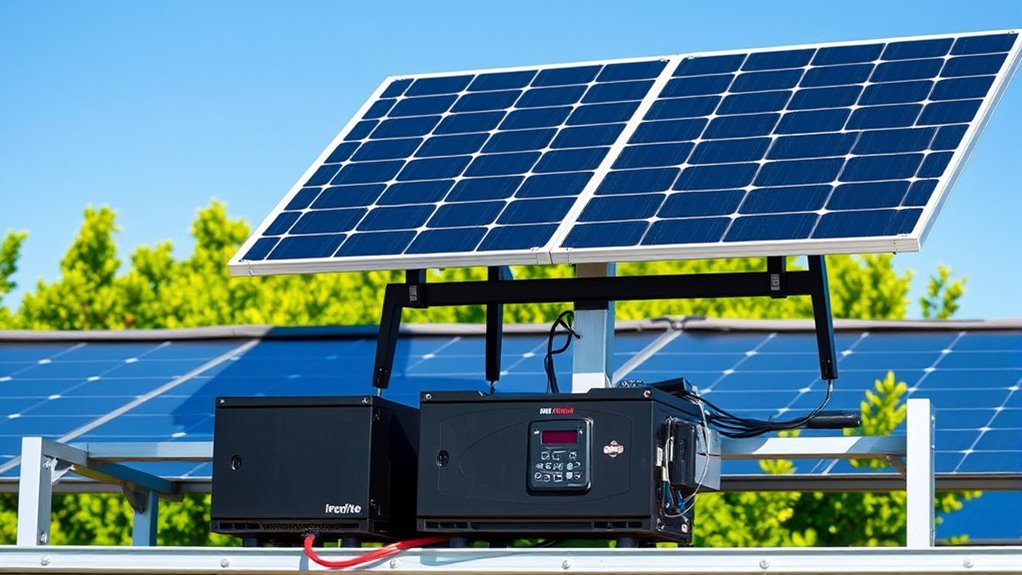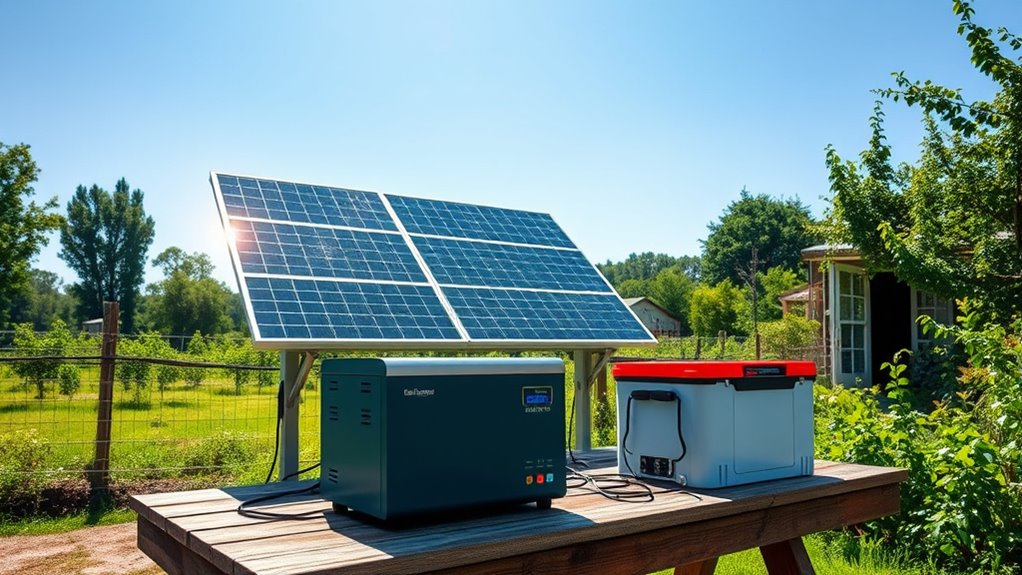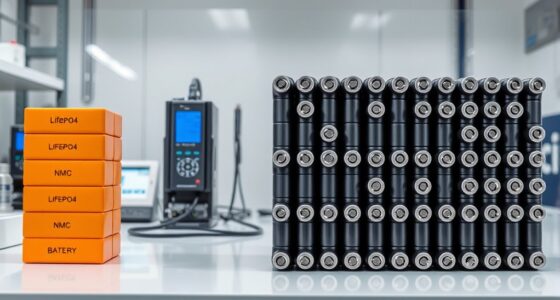Setting up a solar microgrid for home resilience involves installing solar panels to generate power and integrating battery storage to keep your home functioning during outages or bad weather. First, assess your energy needs and choose the right system size. Select high-quality batteries and inverters, and include safety and management systems. Proper planning guarantees reliable, independent energy. If you want to discover more about designing an effective microgrid, continue exploring the essential components and strategies.
Key Takeaways
- Assess household energy needs and determine appropriate solar panel and battery storage capacity for reliable power.
- Select high-quality batteries, such as lithium-ion, and ensure system components are compatible and properly integrated.
- Incorporate efficient inverters and control systems to manage energy flow and maintain system stability.
- Design the system with modular components to allow future expansion and upgrades.
- Implement safety, monitoring, and maintenance protocols to ensure long-term system performance and resilience.

Have you ever wondered how to guarantee your home stays powered during outages or extreme weather? Setting up a solar microgrid can provide the reliable energy solution you need. At the core of this setup is battery storage, which allows you to store excess solar power generated during sunny days for use when the sun isn’t shining. This not only guarantees a continuous power supply but also makes your home more resilient against grid failures. By integrating battery storage into your microgrid, you gain the ability to operate independently of the main grid, achieving what’s called grid independence. This means that even if your utility’s power goes out, your home can keep running smoothly on stored energy, giving you peace of mind during storms or emergencies.
To get started, first assess your energy needs and the capacity of your solar array. Installing enough solar panels ensures you generate sufficient electricity during the day, which can then be stored in your batteries. The size of your battery storage system should match your typical energy consumption patterns and the duration you want to be self-sufficient. Once your solar panels and batteries are in place, you’ll need an appropriate inverter to convert the DC power from your panels and batteries into AC power usable in your home. A dependable control system is also essential, as it manages the flow of electricity, prioritizes the use of stored energy, and maintains system stability. Additionally, understanding the cost and budgeting involved can help you plan effectively for your microgrid project.
Choosing the right components is essential for maximizing your microgrid’s effectiveness. Opt for high-quality batteries with a long lifespan and high efficiency, such as lithium-ion options. These batteries not only store more energy in a smaller space but also require less maintenance. When designing your system, consider future expansion; a modular approach allows you to add more batteries or solar panels as your needs grow. Implementing a proper safety and monitoring system is equally important, enabling you to track performance, detect issues early, and ensure safe operation.
Frequently Asked Questions
How Much Does a Solar Microgrid System Cost to Install?
A solar microgrid system typically costs between $10,000 and $50,000, depending on size and features. For accurate cost estimation, consider your energy needs and system complexity. You can explore financing options like loans or leasing programs to make installation more affordable. Keep in mind that incentives and rebates may reduce your out-of-pocket expenses, making the investment more accessible and financially viable.
Can I Expand My Microgrid in the Future?
Yes, you can expand your microgrid in the future. Studies show that over 70% of microgrid owners plan for scalability options from the start. Planning ahead permits easier future expansion, whether adding more solar panels, batteries, or integrating new energy sources. By designing your system with scalability options, you ensure your microgrid adapts to growing energy needs, making your home more resilient and sustainable over time.
What Maintenance Is Required for a Home Solar Microgrid?
You need to regularly check your inverter to make certain it’s functioning correctly and monitor your battery upkeep to prevent issues. Keep the batteries clean, inspect connections, and make sure they aren’t overcharged or drained too deeply. Periodically, clean solar panels to maximize efficiency. Staying on top of these maintenance tasks helps your home solar microgrid run smoothly, saving you money and ensuring reliable power during outages.
How Long Does It Take to Install a Solar Microgrid?
Time, like a steady river, flows differently for each solar microgrid install. Typically, it takes about 4 to 8 weeks, depending on system complexity, to complete the setup. During this period, your installer guarantees ideal solar panel efficiency and sufficient energy storage capacity. Factors like permits, site readiness, and equipment delivery influence the timeline, so patience ensures a resilient, efficient system that powers your home sustainably.
Are There Government Incentives for Installing a Microgrid?
Yes, there are government incentives for installing a microgrid. You can access government grants and policy incentives that help reduce your installation costs and encourage renewable energy adoption. These programs vary by location, so it’s essential to check with local or federal agencies for current offerings. Taking advantage of these incentives can make your microgrid project more affordable and accelerate your journey toward resilient, sustainable energy independence.
Conclusion
By embracing a solar microgrid, you gently shift towards a more dependable and sustainable home energy future. It’s like adding a quiet guardian that keeps your life running smoothly, even when the world outside faces uncertainties. With this subtle upgrade, you’re not just investing in power—you’re nurturing resilience and peace of mind. So, consider this your gentle nudge toward a brighter, more self-reliant tomorrow, where your home quietly stands strong through any storm.









